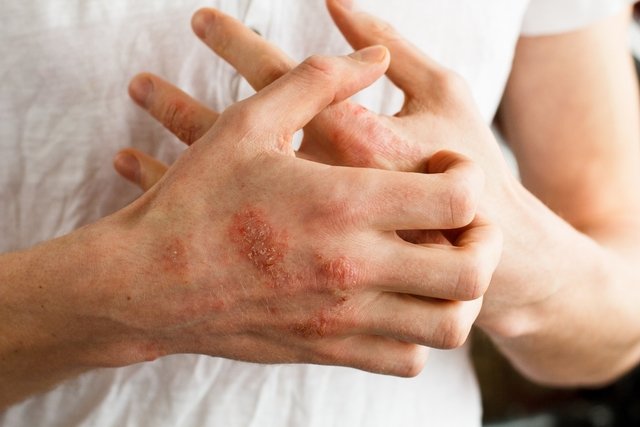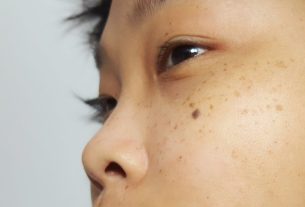Nummular dermatitis is an inflammation of the skin that causes the appearance of red, coin-shaped spots that cause intense itching and can lead to peeling of the skin.
This type of dermatitis, also called nummular eczema, is more common in winter, due to dry skin, and is more common in adults between 40 and 50 years old, although it can also occur in children.
The diagnosis is made by a dermatologist by observing the characteristics of the spots and the symptoms reported by the person. After confirming the diagnosis, the doctor may indicate the start of the most appropriate treatment to alleviate symptoms, and the use of medications or ointments may be recommended.

Main symptoms
The main symptoms of nummular dermatitis are:
- Red coin-shaped spots on the skin;
- Intense itching of the skin;
- Formation of small blisters, which can rupture and form crusts;
- Burning of the skin;
- Peeling of the skin.
The characteristic spots of nummular dermatitis can appear on any part of the body, but are more common on the legs, forearms, hands and backs of the feet.
It is important that the dermatologist is consulted as soon as the symptoms of nummular eczema have been identified, as this will allow the skin lesions to be assessed, the diagnosis confirmed and the most appropriate treatment initiated.
Online symptom test
Nummular dermatitis is a type of dermatitis, such as stasis dermatitis and seborrheic dermatitis. To find out if you have dermatitis, please indicate your symptoms below:
This test is a tool that only serves as a means of guidance and is not intended to provide a diagnosis or replace consultation with a dermatologist or general practitioner.
How the diagnosis is made
The diagnosis of nummular dermatitis is made by the dermatologist initially by evaluating the signs and symptoms presented by the person, mainly observing the characteristics of the spots on the skin.
Taking care of your health has never been easier!
When there are signs of inflammation, the doctor can collect secretions from the lesion to assess whether there is any associated bacterial infection.
Causes of nummular dermatitis
The causes of nummular dermatitis are not yet fully understood, however it is believed that it may be related to atopic dermatitis.
Some factors may favor the appearance of symptoms, such as dry skin, due to hot baths, dry or excessively cold weather, skin contact with factors that cause irritation, such as detergents and fabric, in addition to bacterial infections.
How the treatment is carried out
Treatment for nummular eczema is recommended by a dermatologist and is normally done with the use of oral medications or ointments containing corticosteroids or antibiotics. Furthermore, it is important to drink plenty of water to keep your skin hydrated and avoid taking very hot showers.
One way to complement treatment for nummular eczema is phototherapy, also known as ultraviolet light therapy. Check out more details on eczema treatment.
Bibliography
- BRAZILIAN SOCIETY OF FAMILY AND COMMUNITY MEDICINE. Eczema. Available at: <http://www.sbmfc.org.br/wp-content/uploads/media/NHG%2038%20Eczema(1).pdf>. Accessed on 23 Sep 2021
- NOGUEIRA, Catarina P.; SOUTO, Inês V.; BRANDÃO, Margarida; ROCHA, Rui. Nummular eczema – a diagnostic challenge. . . . Rev Port Med General Family. Vol 35. 330–334
- ANTUNES, Adriana A.; SOLÉ, Dirceu; CARVALHO, Vânia O. et al. Practical update guide on atopic dermatitis – Part I: etiopathogenesis, clinic and diagnosis. Joint position of the Brazilian Association of Allergy and Immunology and the Brazilian Society of Pediatrics. Arq Asthma Allerg Immunol. Vol 2. 1 ed; 131-156, 2017
- BRAZILIAN SOCIETY OF DERMATOLOGY. Eczema. Available at: <https://www.sbd.org.br/dermatologia/pele/doencas-e-problemas/eczema/70/>. Accessed on 23 Sep 2021

Sign up for our newsletter and stay up to date with exclusive news
that can transform your routine!
Warning: Undefined array key "title" in /home/storelat/public_html/wp-content/plugins/link-whisper-premium/templates/frontend/related-posts.php on line 12
Warning: Undefined array key "title_tag" in /home/storelat/public_html/wp-content/plugins/link-whisper-premium/templates/frontend/related-posts.php on line 13



